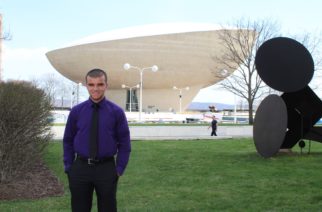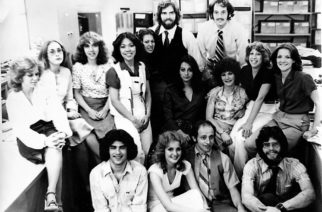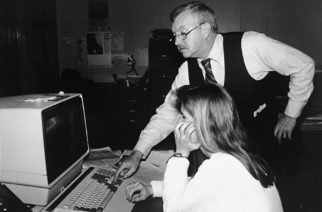“Make sure you bring your own typewriter.”
That was among the last instructions I got as I signed up for this new adventure call The Legislative Gazette. We were already a few weeks into the spring semester. I was restless and ready to rethink my college career. Again. I had dropped out after a year at SUNY Oswego, worked a year at a steakhouse on Long Island and gotten through the fall semester at SUNY New Paltz, but something still wasn’t making sense. My adviser – English and journalism professor Lee Heinz — suggested this new internship program.
I was 20-years-old, restless and ready. I dropped all the classes I was taking, signed up for the Gazette course numbers and boarded a Trailways bus to Albany the next morning, an address, a letter of introduction and my typewriter in hand.
That first office — and it was one small office about 8 x 10 — was on the second floor at 217 Lark Street home to the National Education Association. In that one office was one desk, one phone and one very scary editor named Glenn Doty. He would become our coach, our critic, our champion and our rewrite man all in one.
It’s hard to grasp what it was like in those days before cell phones and instant video feeds and live 24/7 coverage of everything imaginable. We spent hours in committee meetings taking notes on bills, talking to the sponsors and their staff, trying to get a sense of the rhythm of this strange world that was the New York State Legislature. We walked the halls of the LOB and had to actually go to an office to make an appointment, often stopping in again and again – and again.
We were awed and overwhelmed at times. The buildings themselves, the history, the maze of the Capitol, the underground “subway” we found from the Alfred E Smith building to cut some of the bitter cold walks. The language of laying aside and holding and aging and slow roll calls. The debates on the floor — the death penalty, Medicaid funding for abortions, the budget battles — all happening right in front of us.
And what debates. To hear Dominic DiCarlo and Stanley Fink go at it over juvenile justice bills was to listen to the passion of policy differences rising at times to an angry, fevered pitch — Fink the Chair of Codes that year and DiCarlo the ranking minority member. To see them later that night at the same restaurant, stopping at each other’s tables and enjoying each other’s company was stunning at first and a bit disorienting until I realized the respect they had for each other despite their differences.
I’m sure I’m not alone among Legislative Gazette alum to remember the power and pride of walking onto the floor of the Senate and Assembly during our first session, reporter’s credentials in hand. That first year it was thanks to the incredible members of the Legislative Correspondents Association (LCA) who first gave us those credentials, allowing us to sit in the press chairs below the podium in each house to capture the debates and do our job.
Hand-written notes in our reporter’s notebooks, long and slim so you could hold them in your hand, we headed back to that little office, often perching on the stairs or on the floor in the vacant front office area to bang out our stories. We’d hand them to Glenn and within minutes they would be tossed back to us, red marker indicating where we literally had to cut and paste the story back together. “This is your damn lead… move it up… bury this… “ And so, with scissors and rubber glue we would cut out the lead we had buried in paragraph four and paste it at the top of what became a “scroll” and handing it back for final proof reading. Many a week I ended those editing sessions close to tears and completely wiped out, but Glenn would give a “good work kid” on his way to the printer and all would be better.
All those scrolls would somehow become a newspaper. By Thursday afternoon we were wrapping up and everything was dropped off at the Jewish World Press on Central Avenue where each story would be re-typed into machines producing photo-ready copy to be (again literally) pasted onto gallies to be printed. Photos added, headlines printed, the masthead checked and we were good to go. Monday morning we’d have papers to deliver – and deliver we did, hauling stacks of papers and hitting our assigned floors of the LOB or Capitol going door to door.
So it began – February 21, 1978 Volume 1, Number 1 was delivered – the brainchild of Alan Chartock, produced by seven very new untested reporters and one very seasoned no-nonsense editor.
It almost ended as soon as it began.
The legislative leaders certainly weren’t used to having their members — and their members’ work — covered on such a regular basis. Some in the leadership staff — in the Senate Majority in particular — were not all that thrilled to have a bunch of college students — from New Paltz no less — prowling the halls of the LOB and sitting in on any committee meeting they felt like covering, talking to staff and quoting rank and members on anything and everything. The Open Meetings Law was in its infancy and the control of information by the leadership was unquestioned.
One Monday morning early in our first year of publication word came from the administration at New Paltz. We were to “cease and desist” — our little experiment was done and the paper was being shut down. It was a good run, Alan told us during our weekly seminar, but it’s over. “Not on your life,” I thought.
He likes to tell the story of how I saved the Gazette — and it’s true how I went to the AP and the New York Times reporters over in the Capitol and told them we had to leave and didn’t know why. How they in turned made some well-placed calls for comment and got some very embarrassed very high level staff on the phone saying it was all a mistake, of course the state was not shutting down any newspaper – student produced or otherwise, how it was wonderful that government was opening up and young people were getting involved. And so The Legislative Gazette was saved.
The truth is I was saving myself. I couldn’t face going back to campus, to classes that meant nothing and a life going nowhere. The amazing thing is the Legislative Gazette — that little student newspaper — put it all in focus for me. Political Science classes took on more meaning, history fell into place a bit more, journalism classes became critical. For the next three years I would spend fall semesters in class and the spring in Albany with the Gazette. I became editor of the campus newspaper, the Oracle, a weekly that ran 32 pages to the Gazette’s 16 or 20 pages at that point — but it was The Legislative Gazette and covering state government and politics that engaged me and gave me direction.
Donna Caccio and I came back as student editors in year two. We created an glossary of legislative terms, walked everyone through the rhythms of the houses and gave the new reporters a tour of the Capitol and LOB, showing them the short cuts, the “subway” and the offices tucked away on the 4th and 5th floor of the capitol where some of the best staff sources had their offices.
Our offices were now at 260 Washington Ave – huge and open with desks for everyone and at least three or four phones. We all still brought our own typewriters and we all still answered to the one and only Glenn Doty who would edit the paper for 23 years. We still hit the pavement and prowled the Capitol and LOB looking for stories and covering the weekly workings of the legislature. We now had reporters who doubled as photographers. We had our weekly seminars with Alan and we wrote our academic papers along with the newspaper. We had enough students that we had assigned beats and we still had that Thursday deadline looming every week. We made it work.











